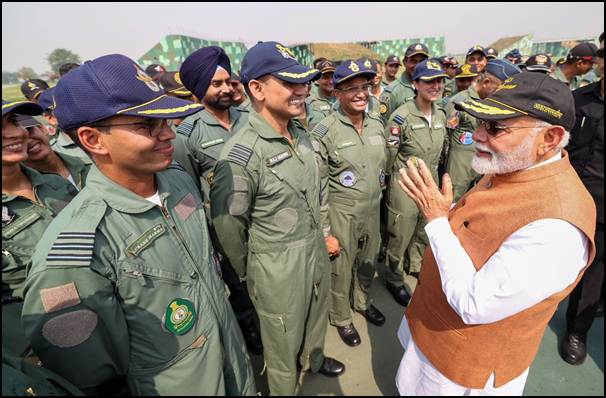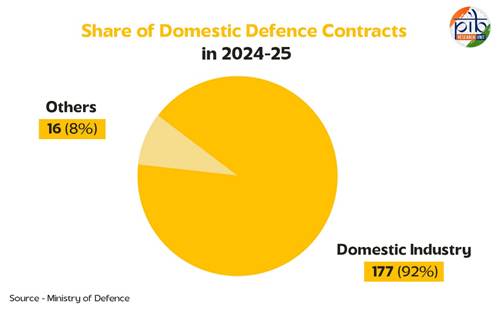As the Prime Minister Narendra Modi-led NDA government completes 11 years in office, India’s defence sector marks a decade-long shift towards self-reliance, driven by focused policy interventions, enhanced budget allocations, and institutional reforms.
The defence budget has increased from ₹2.53 lakh crore in 2013–14 to ₹6.81 lakh crore in 2025–26. The sharp rise in allocations reflects a sustained push towards capacity building and indigenisation in the sector. Over the years, a strong emphasis has been placed on developing a domestic ecosystem that supports manufacturing, innovation, and exports.
In 2023–24, India registered its highest-ever defence production, reaching ₹1.27 lakh crore. This marks a 174 percent increase over the ₹46,429 crore recorded in 2014–15. The growth is attributed to policies promoting indigenous manufacturing and procurement.
The Ministry of Defence signed 193 contracts worth ₹2,09,050 crore in 2024–25, the highest recorded in a single financial year. Of these, 177 contracts were awarded to domestic industries, accounting for ₹1,68,922 crore. This aligns with the government’s priority for domestic procurement under the Defence Acquisition Procedure 2020.
To support defence manufacturing infrastructure, two dedicated Defence Industrial Corridors have been established in Uttar Pradesh and Tamil Nadu. As of February 2025, these corridors have attracted investments worth ₹8,658 crore, with 253 Memorandums of Understanding signed. The total investment potential is estimated at ₹53,439 crore.
The government has released five Positive Indigenisation Lists, covering over 5,500 items. As of February 2025, 3,000 of these items had been indigenised. The lists include key technologies such as artillery guns, assault rifles, radars, light combat helicopters, armoured platforms, and communication systems.
Innovations for Defence Excellence (iDEX), launched in April 2018, has played a central role in promoting innovation. Grants of up to ₹1.5 crore have been extended to startups, MSMEs, and research entities. As of February 2025, 549 problem statements have been published, with 430 contracts signed involving 619 participants. The armed forces have procured 43 items worth over ₹2,400 crore from iDEX-supported firms.
For the financial year 2025–26, ₹449.62 crore has been allocated to iDEX, including its sub-scheme ADITI (Acing Development of Innovative Technologies with iDEX).
Among infrastructure initiatives, the Defence Testing Infrastructure Scheme (DTIS) aims to support the creation of eight greenfield testing and certification facilities. Seven of these have already been approved, focusing on domains such as electronic warfare, unmanned systems, and communication technologies.
Foreign Direct Investment (FDI) in the defence sector was liberalised in September 2020. The policy now permits up to 74 percent FDI through the automatic route and more than 74 percent through the government route. Since April 2000, the sector has received FDI worth ₹5,516.16 crore.
The Tata Aircraft Complex, inaugurated in October 2024 in Vadodara, is manufacturing C-295 transport aircraft. Of the 56 aircraft under the programme, 40 are being built in India.
Manthan, an annual innovation event held during Aero India 2025 in Bengaluru, has continued to provide a platform for collaboration among startups, academia, and defence stakeholders.
For 2025–26, the Ministry of Defence has allocated 75 percent of its modernisation budget—₹1,11,544 crore—for procurement from domestic sources, reinforcing its focus on building an indigenous defence industrial base.















